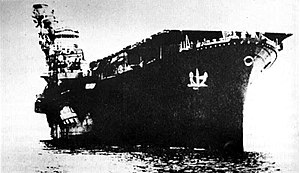Hiyō-class aircraft carrier

Hiyo at anchor
|
|
| Class overview | |
|---|---|
| Operators: |
|
| Preceded by: | Shōkaku class |
| Succeeded by: | Taihō |
| Built: | 1939–1942 |
| In commission: | 1942–1945 |
| Completed: | 2 |
| Lost: | 1 |
| Scrapped: | 1 |
| General characteristics (Junyō as built) | |
| Class and type: | Hiyō-class aircraft carrier |
| Displacement: | 24,150 metric tons (23,770 long tons) (standard) |
| Length: | 219.32 m (719 ft 7 in) (o/a) |
| Beam: | 26.7 m (87 ft 7 in) |
| Draft: | 8.15 m (26 ft 9 in) |
| Installed power: |
|
| Propulsion: |
|
| Speed: | 25.5 knots (47.2 km/h; 29.3 mph) |
| Range: | 11,700 nmi (21,700 km; 13,500 mi) at 18 knots (33 km/h; 21 mph) |
| Complement: | 1,187–1,224 |
| Sensors and processing systems: |
1 × Type 2, Mark 2, Model 1 air search radar |
| Armament: |
|
| Armor: | |
| Aircraft carried: | 48–53 |
The two Hiyō-class aircraft carriers (飛鷹型航空母艦 Hiyō-gata kōkūbokan?) were built for the Imperial Japanese Navy (IJN) during World War II. Both ships of the class, Hiyō and Junyō, were originally laid down as luxury passenger liners before being acquired by the IJN for conversion to aircraft carriers in 1941. Junyō was the first of the sister ship to be completed in May 1942 and the ship participated in the invasion of the Aleutian Islands the following month. Both ships participated in several battles during the Guadalcanal Campaign in late 1942. Their aircraft were disembarked several times and used from land bases in a number of battles in the South West Pacific.
Hiyō was torpedoed in June 1943 and Junyō in November; both ships spent about three months under repair. They spent most of the time after their repairs training and ferrying aircraft before returning to combat. Hiyō was sunk by a gasoline vapor explosion caused by an American torpedo hit during the Battle of the Philippine Sea in mid-1944 while Junyō was damaged by several bombs. Lacking aircraft, she was used as a transport in late 1944 and was torpedoed in December. The ship was under repair until March 1945 when the repairs were deemed uneconomical. Junyō was then effectively hulked for the rest of the war. The ship was deemed not worth the cost to repair by the Americans after the surrender of Japan in September and she was broken up in 1946–47.
...
Wikipedia
